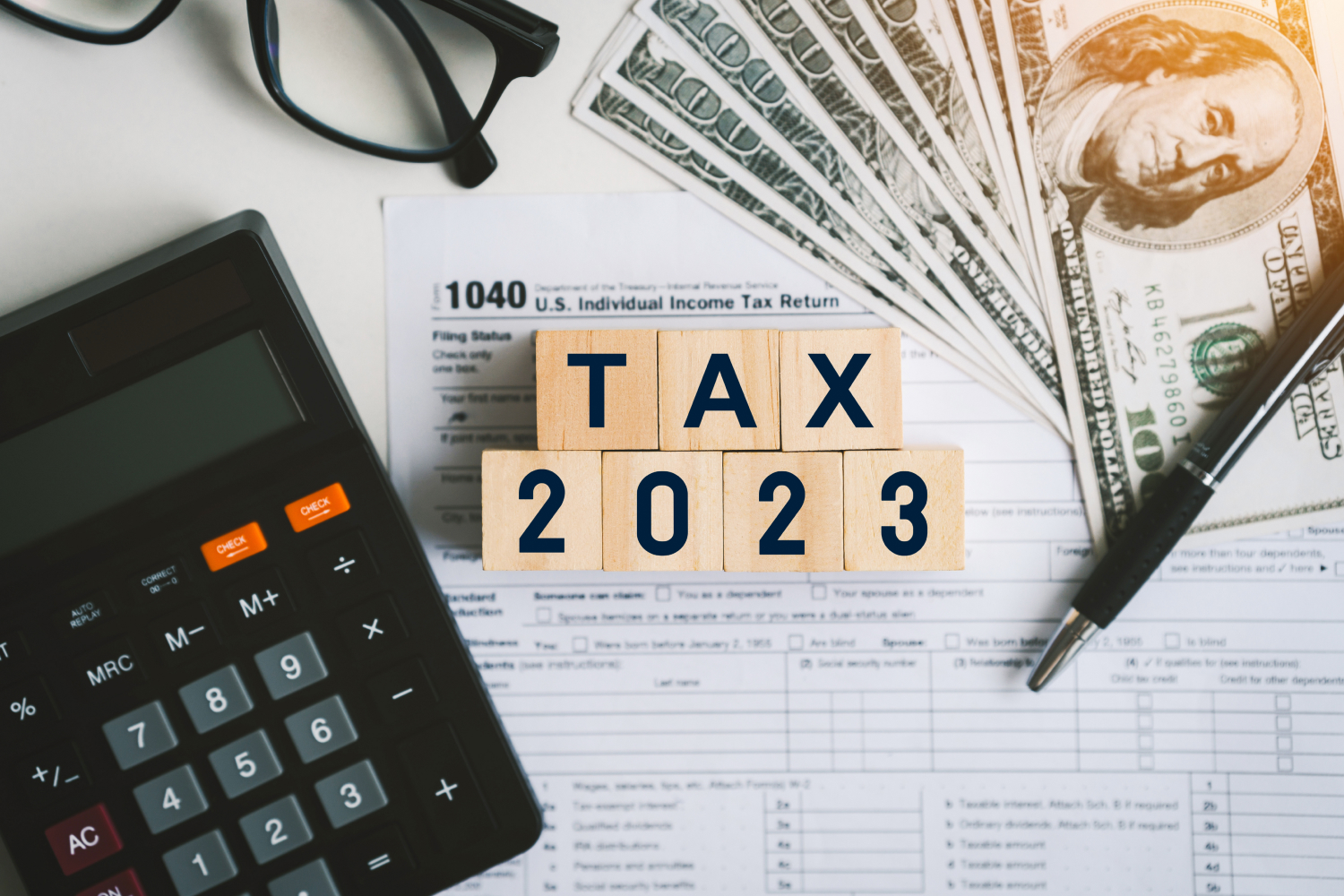10 Smart Ideas for What To Do With Your 2023 Tax Refund

Two things in life are famously inevitable: death and taxes. Not many people are fans of either, but one underrated silver lining of paying taxes is receiving your tax return in the mail or online. It’s like a little economic thank you card from Uncle Sam.
So, what can you do once you get your tax refund? We cover some wise options below.
What Is a Tax Refund?
If you’re a young person who has just joined the workforce, you may feel extremely confused and overwhelmed by doing your taxes on your own for the first time. When you do your taxes and submit your tax return, you detail all the income you had last year and any tax deductions you may benefit from.
After the IRS processes your documents, they determine how much to refund you. You are then issued a refund check by the state and/or federal government.
But what do you do with it? What’s the smartest thing you can do with this little bonus check? We at Red Pocket want to help our customers be smart with their money, so we have a few suggestions on what to do with your 2023 federal income tax refund.
1. Put it in a High-Yield Savings Account
Saving extra income for a rainy day is always wise — so wise that your grandmother has probably already told you to stick every spare penny in a savings account. However, a high-yield savings accountis not your grandma’s piggy bank, it does so much more! Opening and growing your high-yield savings account is a money goal everyone should have.
The intersection of an investment and a savings account is a high-yield savings account. Most savings accounts earn abysmally little interest. Most standard savings accounts earn less than 1%, with the national average at .33% — and many earn even less than that!
It’s like you gave your bank an interest-free loan — something they likely wouldn’t give you. A high-yield savings account will earn you significantly more interest in a more reasonable time span. High-yield accounts won’t always label themselves as such, it’s up to you to look for accounts with higher than average interest yield, so it’s up to you to do your research.
What Is a High-Yield Account?
Different bank accounts from different banks will earn different interest rates, so what qualifies as a high-yield account? Generally, any account offering more than 3% interest is considered a high-yield account.
You typically need to set up a direct deposit from your employer to benefit from this interest rate, so you can’t use just your tax refund. However, once you’ve got one open, you can make your own deposits, such as your refund, whenever you’d like. Some professions, like teachers and firefighters, have occupation-specific credit unions that offer accounts with interest rates as high as 6%.
When you shop around for your account, always read the fine print. Look for an account that doesn’t penalize you for making withdraws when you need to. Also, ensure the high interest rate isn’t scheduled to end or an introductory offer.
Use this account to create an emergency fund: Aim to have at least two months of living expenses saved here, and do not touch it until a particularly rainy day when you encounter an emergency like job loss or severe medical expenses.
2. Invest It
You worked hard for your money. Make it work hard for you.
Even though it may feel like your refund is free money, you still had to work to get it. When you invest your spare income, you give it the opportunity to grow even further. There are many different ways to invest, like stocks, real estate, bonds, and mutual funds.
When you get started investing, it may seem overwhelming. The entire process of investing was designed to be convoluted and prohibitive. There have always been banks and companies that will handle your portfolio for you, but these often come with higher fees and demand more knowledge of the stock market.
Luckily, there are a ton of modern companies (like Ellevest and Acorns) aiming to make the process more accessible for a smaller fee. Whether you want to outsource this endeavor to a dedicated company or venture forth on your own (or even a combination of the two), you are capable of investing.
Before you make your first investment, start by setting specific, measurable, and attainable financial goals for the capital you’re investing. Assess your personal tolerance for risk and your personal ability to manage your own portfolio, both in terms of skill and time. Research different robo-advisors from different money management companies. Investing is a big animal to tame, but with a little dedication, anyone can learn how to grow their wealth through smart investing.
3. Put It Toward Paying Off Your Debt
Most Americans have some amount of debt: student loan debt, credit card debt, and more. Paying down debt is no small feat, and the longer your debt sits, the bigger it will grow. When you have a little extra cash, it would be wise to use it to make a debt payment.
You’ve probably heard this common financial advice, but just because your credit card creates some debt, it’s not a bad thing. A credit card is one of the best tools in your wallet as long as it’s giving you rewards to shop.
A cashback card, a travel points card, or any other rewards program that suits your lifestyle. Make your personal finance choices personal by selecting a card that gives you rewards you actually want.
4. Invest in Your Home
If you're currently working towards purchasing your first home, or a new home, add your refund to your savings for a down payment. If you are fortunate enough to own your own home, you want your home to be the best it can be.
After all, owning a home is a major investment in the first place, and it’s up to you as a homeowner to manage the home’s upkeep year after year. Some homes, especially older homes, demand more upkeep than others. Home design and decor trends change over time, and sometimes you want to give your space more than just a fresh coat of paint or a new refrigerator.
Consider investing your time and refund into that home improvement project you’ve been considering. New year, new bathroom!
5. Invest in Your Education
Beyond making a payment on existing student loan debt, there are other ways to invest in your education. Most community colleges offer continuing education courses for post-grad adults to broaden their educational horizons. There is also a myriad of classes online to feed your curiosity.
Reputable sites like Coursera and Masterclass provide affordable resources to help you pursue a wealth of information in a wide variety of fields. Advance your current career or try something totally new. Of all the smart ways to utilize your tax refund, this one will certainly make you smarter!
6. Invest in Your Business
Do you have an entrepreneurial spirit? Are you a small business owner? Then you know how to utilize capital to grow your business. There is a myriad of options when it comes to investing in your business: marketing, SEO improvement, team development, new equipment, outsourcing unpleasant tasks, and much more.
As a business owner, you know how many plates you have to keep spinning at one time. Having a little extra to invest might allow you to hand a plate to someone else. Even ensuring that your business has a cash buffer in case of an emergency would be a smart idea.
7. Plan Ahead With a New Phone Plan
Don’t wait until emergency strikes: Plan ahead with a new phone plan. Your phone is probably one of the most important tools in your life. Think about it: you use it every day, it likely never leaves your side, and it can do nearly anything as long as it has a signal. So, ensure you always have a signal, and at a great price, too.
You want a phone plan that’s reliable but won’t demand your entire tax refund. Consider switching to Red Pocket to get a better deal on the same nationwide coverage offered by the major carriers. Seriously, we use the exact same cellular networks as the nation’s major carriers.
Red Pocket has plans to fit every budget and every cell phone plan need. With some of the best rates in the industry on annual plans and monthly plans, Red Pocket can help you and your family get the best bang for your buck without compromising quality.
We don’t do hidden fees, activation fees, or early termination fees, so the price you see is the price you pay. Red Pocket operates on all three major US networks, so there will be no spotty coverage and no slow speeds. All Red Pocket plans are 5G compatible.
No contract phone plans are what we do best. No contract means no rigid commitment, so you can modify your plan whenever you want. If you suddenly need more or less data, we can help you adjust your plan accordingly. But the best value of all? Our commitment to our customers.
We have a number of ways to get in touch with us so we can help. You can even text us!
8. Donate To Charity
When you have a little to spare, thinking of those in need is a kind thing to do. We all have a cause or a charity close to our hearts, from animal shelters to food banks to children’s hospitals.
Consider making a donation to charity and start this year off right, knowing that you helped another person (or an animal or the environment or society at large). Also, that donation will be tax deductible for next year’s tax return, making your tax refund the gift that keeps giving!
9. Treat Yourself
You are more than allowed to use your tax refund to treat yourself. We give you permission. Make a frivolous purchase that sparks joy. A little trip, new clothes, the latest video game — whatever speaks to you.
Maybe even a new phone or tablet! If the latest tech sounds like the splurge for you, let us help you have some extra cash left over for your other treats. Red Pocket has an awesome selection of the latest Apple and Android devices at great prices.
Right now, you can get an iPhone 14 Pro Max for just $670 with a Red Pocket phone plan! With a Red Pocket plan, you could also get a Samsung Galaxy S20 Plus for just $750. Life is short; using your tax refund to treat yourself is smarter than you think.
10. Plan Ahead for Retirement
Similar to the investment discussion above, you can invest in a Roth IRA or 401(k) retirement account to get ahead for retirement. Whether retirement is six years away or 60 years away, investing in your future, gold-years self is always a smart move.
When you calculate how much you need to retire, include more than just standard living expenses; account for unexpected expenses as well, such as increasing medical costs, the cost of economic inflation, and general unforeseen rainy days.
Where’s My Refund?
After reading these great ideas for smart things to do with your refund, you’re probably excited to receive that check. Try to be patient, every taxpayer in the country is asking the same question, and the IRS has never been known for its efficiency.
In the meantime, strategize your financial plan so you can act as soon as you receive it. And keep an eye on Red Pocket’s always-changing special offers to help you be even smarter with your money.
Sources:
What a high-yield savings account is and how it can grow your money | CNBC
How to Invest Money: Smart Ways to Get Started | NerdWallet
Entrepreneur | 10 Ways You Should Invest Your Company's First Profits | Entrepreneur

